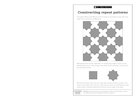Islamic architecture
Add to My Folder
Follow these art-based activities to inspire children to design and make their own patterned, symmetrical artwork
The lessons in this article are inspired by the shapes and patterns found in Islamic architecture, specifically the mosque, which is the Muslim place of worship. In completing these activities, children will have opportunities to explore a range of patterns. They can begin by making clay tiles inspired by designs from the Islamic world, and experiment with repeating collaged patterns based upon the architecture of the mosque. Most children in the class will be fascinated by the complex patterns to be found in Islamic art and design, and the activities provided here should enable them to make valuable links with their work on shape and space.
Essential facts
- ‘Mosque’ means masjid in Arabic, which means ‘place of prostration’, and it is where Muslims gather to pray. Prayer is one of the Five Pillars of Islam, and Muslims regard it as being of central importance to their religion.
- Mosques are often beautifully designed buildings. Many feature elegant domes and some have tall towers (‘minarets’), from which you can hear people being called to prayer by the muezzin. Mosques are not only places where Muslims pray, but also centres for the local Muslim community: they have rooms where people can meet, and even shops, where the Qu’ran can be bought.
- Mosques are usually elaborately decorated. You will not find any images of animals or people in a mosque, however. This is because Muslims believe that they should pray directly to God, and not through images of a deity.
- Tiles have been made in the Islamic region for over a thousand years, and are used to adorn both religious and secular buildings. The climate in Muslim countries is very hot, and tiled surfaces can help to cool people down.
- Many Islamic tiles feature geometric designs – some designs are simple, some are very complex, and they are often quite beautiful. If you study the patterns on the tiles closely, you will see that they are usually made by building up repeat patterns of simple shapes that come together to form complex compositions. Show children the ‘Tiles patterns’ poster to give them an idea of patterns and colours.
- Mosques sometimes have gardens, and if you look at a range of Islamic tiles and rugs, you will see that their patterns are often inspired by flowers. Many Islamic artists prefer to use cool colours such as blues, greens and yellows.
Scholastic Resource Bank: Primary - join today!
- Over 6,000 primary activities, lesson ideas and resources
- Perfect for anyone working with children from 5 to 11 years old
- Unlimited access from just £1.25 per month
Already a member? Sign in below.
Published 26 September 2007
Reviews
You need to be signed in to place a review.


